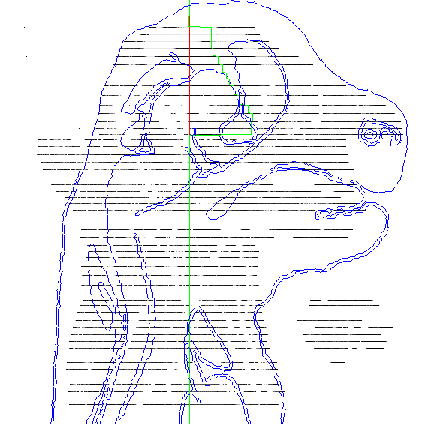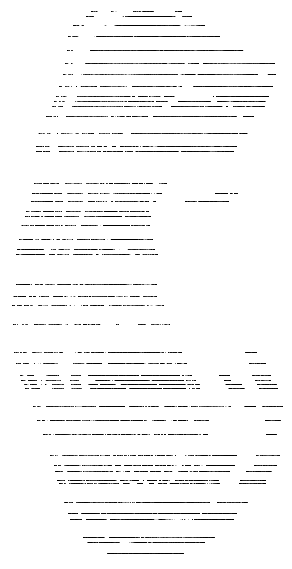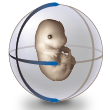Image Processing - Method 2
Protocol
Image Capture
Histology sections were captured as digital images as described in Image Capture - Configuration E
Reconstruction
The reconstruction process builds up the 2D digital sections into a 3D stack that can be digitally cut in any direction to produce a representation of a true mouse embryo section. The original sections are transverse. Simple pairwise registration of the images will not, in general, recover the embryo shape. Furthermore, deformation of the sections, mean that perfect alignment cannot be achieved. We therefore define key sections which are aligned to a shape template in 3D and then fill the gaps by a process of automatic alignment and warping. Approximately every 20th section (a key section) was taken to make a skeleton 3D embryo and each of these sections individually transformed in the x and y plane to fit a frontal and sagittal template. Figure 2 shows the process and Figure 3 the final best fit results.
| Figure 2: This figure shows the alignment of the key sections to the blue sagittal template. The green line shows the transformation of the sections to fit the template. |
 |
| Figure 3a: This is a sagittal view of the final alignment. The key section skeleton went through 40 iterations of manual alignment to get the best fit | Figure 3b: A frontal view of the same object and transformations. The voxel size at this stage is approximately 20 x 20 x 14 microns hence the elongation of the model |
 |
 |
From the key section model the missing sections are put in between. This is achieved by reconstructing the data in blocks using a key section at the top and bottom of each block. Every second section in the model is actually a key section the ones in between are alignment sections to give a better overall shape of the embryo. The final 3D model is constructed from the union of each of these blocks. In this embryo 56 key sections were chosen at stages where there was considered to be a significant change in the anatomy of the sections. Figure 4 shows an actual sagittal section taken from a similarly aged mouse embryo. In comparison Figure 5 shows a sagittal (a) and frontal (b) view of the current constructed 3D model. There are obvious distortions in the image but the organs and internal structures can clearly be seen and are comparable with the section in Figure 4.
| Figure 4: This figure shows an original sagittal section of a similarly aged mouse embryo | Figure 5a: This is a sagittal view of the full 3D model. Every 2nd section has been used to make the object a more manageable size (~400MB). |
 |
 |
| Figure 5b: This is a frontal view of the full 3D model. The voxel size of the model is now approximately 13.3 x 13.3 x 14 microns to give a more realistic looking mouse. |
 |
Figure 5 shows that there is missing information and angle changes in the data due to the sectioning and histological processing. It is hoped to correct these using other specimens (particularly the brain region) and imaging techniques (angle changes in the upper body regions). By using warping techniques developed at HGU the aim is to smooth the data to give a more representative shape of the embryo and remove the jagged distortions. The key sections remain static throughout acting as anchor points during this process. The full size model will be x2 in the x, y and z planes hence in full resolution the model will 23 x 400 = ~3200MB. At the moment this is an unmanageable size of data but with ever increasing advances in technology this should soon be a manageable size.




